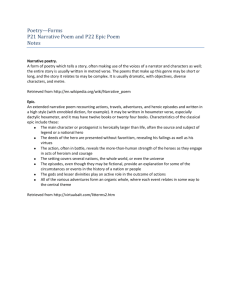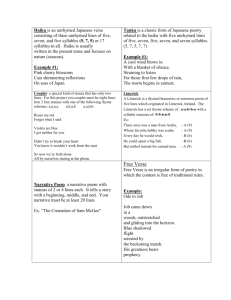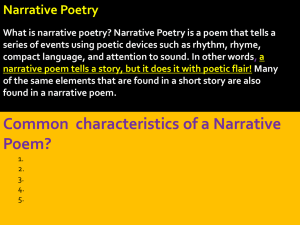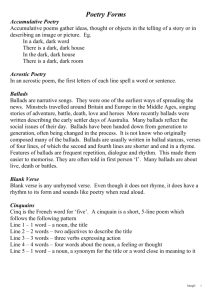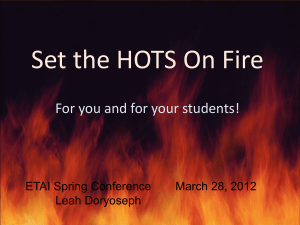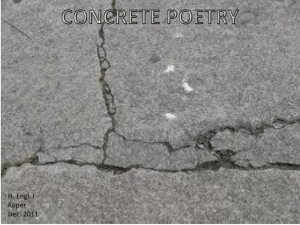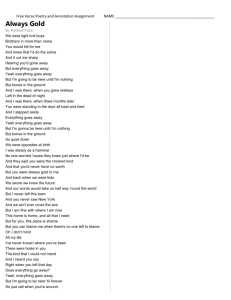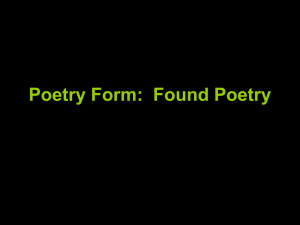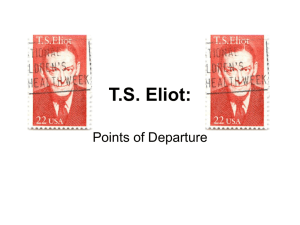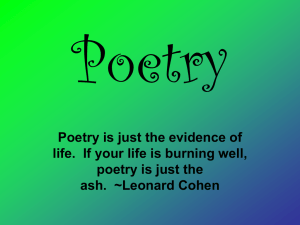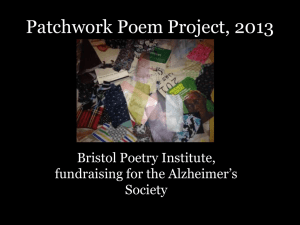ENC1102 Poetry
advertisement
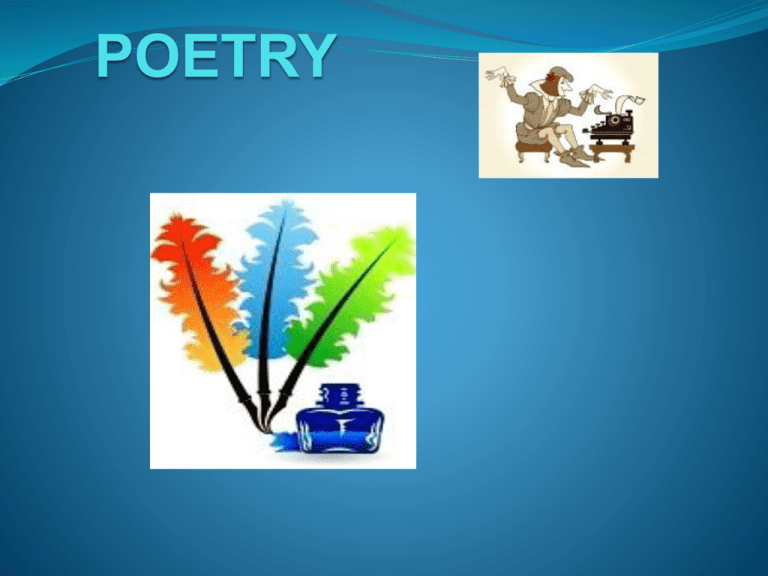
POETRY LYRIC POEM Originally a poem sung to the music of a lyre As written today it is “ …a short poem expressing the thoughts and feelings of a single speaker”. Example: “The Lake Isle of Innisfree” by William Butler Yeats ( p. 633) Narrative Poetry The main purpose is to tell a story. However, the very telling of the story in poetic form explores a larger point. Some narrative poetry is set to music as folk lyrics such as “ Bonnie Barbara Allan” or “ Birmingham Sunday”. The narrative poem may comment on the relevance of the event which it depicts. Dramatic Poetry-Dramatic Monologues Presents the voice of an imaginary character ( or characters) speaking directly without additional narration by the author. A dramatic monologue is a poem written as a speech made by a character ( other than the author) at some decisive moment. Examples “ The Ruined Maid” (685) and “ My Last Duchess” ( 639). Dramatic Monologue Didactic Poetry: A poem written to state a message or teach a body of knowledge. Example : Ovid’s Art of Love Satiric Poetry Poetry which conveys a message This poetry often has a tone of “…detached amusement, withering contempt, or implied superiority” The poet “…ridicules some person or persons or perhaps some kind of human behavior), examining the victim by the light of certain principles and implying that the reader, too, ought to feel contempt for the victim.” Persona: In a poem the speaker is, at times, a fictitious person, not the author of the poem. Example: “The Chimney Sweeper” by William Blake ( page 665) Irony: Often apparent in the distance between the poet and the fictitious character as the poet has adopted an ironic point of view. Example: “ My Last Duchess” and Swift’s “ A Modest Proposal” Allusion: An indirect reference to any person, place or thing- fictitious, historical, or actual. Diction- word choice or vocabulary Concrete- specifically names or describes things or persons. Abstract words that express general ideas or concepts Poetic- strictly speaking any language deemed suitable for verse –generally refers to elevated language rather than language for common use. Levels of diction: Vulgate – lowest level – language of the common people Colloquial English – casual or informal but correct language of ordinary speakers- conversational General English – the ordinary speech of educated native speakers Formal English- heightened, impersonal language of educated persons usually only written. Dialect- A particular variety of language spoken by an identifiable regional group or social class Levels of Diction: Denotation/Connotation: Denotation- The literal, dictionary meaning of a word Connotation- An association or additional meaning that a word, image, or phrase may carry, apart from its literal denotation or dictionary definition. A word may pick up connotations from the uses to which it has been put in the past. Connotations Imagery: In poetry an image suggests a word or sequence of words that refers to any sensory experience Visual- seen Auditory- sound Tactile – touch Also an odor, taste or a sensation such as pain, thirst or prickling of gooseflesh or contact with heat or cold. Images Figures of Speech: Metaphor- A comparison of two things which states that one is the other but implying that the two things share similar qualities. “ Love is a rose.” Simile: A comparison using like or as. Usually a simile compares one quality which two things share whereas a metaphor may address a host of similarities. “Oh, my love is like a red, red rose” Personification : A figure of speech in which a thing , an animal, or an abstract term ( truth, nature) is made human. Example; “The Wind” (739) Apostrophe: A way of addressing someone or something invisible or not ordinarily spoken to. “Death Be Not Proud” (1037) John Donne “ Death be not proud, though some have called thee Mighty and dreadful, for thou art not so;…” Overstatement/ hyperbole : A statement of deliberate exaggeration designed to emphasize a point. Understatement A purposeful minimizing of a situation for humor or emphasis. “ One could do worse than be a swinger of birches.” Metonymy The substitution for the name of a thing with something closely associated with it. Example: The cradle to grave reference refers to the passage from life to death.. Synecdoche A part of a thing stands for the whole of it or vice versa. Example: Lending a hand. Paradox A statement that at first strikes us as self- contradictory, but that on reflection makes some sense . Pun A play on words Ballads: a narrative song /poem Folk Ballads- loosely defined as anonymous story- songs transmitted orally before they were ever written down. Literary Ballads: Ballads not meant for singing – Often imitate certain features of folk ballads telling of dramatic conflicts or of mortals who encounter the supernatural . Example: “ La Belle Dame sans Merci” (872) Free Verse A kind of verse liberated from the shackles of rime and meter. “Writing free verse is like playing tennis with the net down.” Robert Frost Symbols: “ A symbol is like a rock dropped into a pool: it sends off ripples in all directions, and the ripples are in motion.” – John Ciardi Allegory: A description, usually narrative, in which persons, places, and things are employed in a continuous and consistent system of equivalents. Sources: Kennedy, X. J. and Dana Gioia. Poetry. New York: Longman, 2010.print.
